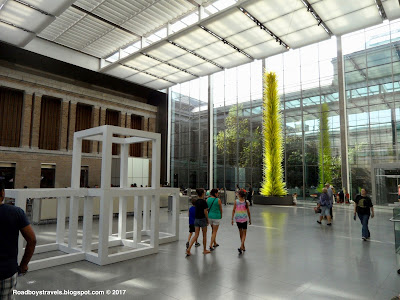Day 3 - A ferry to Winter Harbor and a ride on the Schoodic Peninsula
On day three the titanium colored skies kept threatening us with rain. After our route review we made a quick walk to the Bar Harbor docks to catch the ferry to the Schoodic Peninsula.
On day three the titanium colored skies kept threatening us with rain. After our route review we made a quick walk to the Bar Harbor docks to catch the ferry to the Schoodic Peninsula.
This is the only portion of Acadia National Park that is located on the mainland. On our short ferry ride we passed some gently arching dolphins, a few of the islands beachfront summer "Cottages" (this is island understatement; here a "Cottage"is actually a huge mansion owned by wealthy seasonal residents typically from Stamford, Boston and New York etc.) and seemingly thousands of the little buoys marking a lobster trap below.
The Schoodic Peninsula is a relatively new addition to the park (joining in 2015). Prior to 2015 this area housed a naval base and most recently was attracting the eyes of developers. That all ended when an anonymous donor purchased it that it could be added the park. Its new roadways, jagged granite coastline and quiet fishing villages make for a wonderful day of bicycling. We stopped for an awesome lobster roll and blueberry pie at the Corea wharf before riding back to Winter Harbor for our return ferry back to Bar Harbor.
Lobster Boat Checking Traps
Lobster Traps
Lobsterman's House Perched Over Water
A Decommissioned Lighthouse
Day 4 - The Sand Beach Loop Ride
Dorr's Mansion
We began Day 4 visiting the site of George B. Dorr's Cottage. Dorr (referred to as the "Father of Acadia" and its first park
Superintendent) lived here entertaining anyone he felt could aid in
getting the lands of Acadia acquired for turnover and designation as a
national monument / park. The 30 room cottage was completed built by Dorr's parents in 1880.
He lived here until he died at the age of 90 in 1944. After his death the mansion was then left to deteriorate to a point where it needed to be restored or demolished. The UPS opted to demolish it in 1951. Despite the harsh winters the herringbone brick floors of the enclosed porches still remain almost perfectly intact.
Frenchmens Bay
(Directly in Front of the Dorr Cottage)
Dorr went swimming in Frenchmen's Bay almost every day (even having to chip ice in winter to do it). In fact it was here in 1934 while swimming he suffered a heart attack at age 80. At that time he was told he had six months to live. Instead, he lived another decade.
Passing a Gatehouse to Rockefeller's Carriage Trails
From the Dorr Cottage site we pedaled the Sand Beach Loop road. This road is what 90% of the visitors to the park will see and it includes stops at Thunder Hole and a ranger stop to view falcons nesting in the rock ledges above the road. There was also a stop at Sand Beach where we watched drivers drive round and round looking for a parking space. We parked the bikes and went straight to the nice sandy beach (for swimming if you ave anti-freeze in your veins). One of our riders dove in. I dipped my feet in and discerned that it was indeed refreshing.
If it is that cold in July, my respect for Mr. Dorr's mid-winter swims went way up.
The roads went up and down from waters edge to hugging the cliffs above the shore (translation there were lots of hills).
Next we came to Jordan Pond where many families were busy picking blueberries. The day finished with many of our group making the optional ascent of Cadillac Mountain (which is 3 miles straight up), I passed.
The Road Showcases Acadia's Rugged Coastline
Making Decisions About Climbing Cadillac
The day was filled with sunshine and the ride really energized everyone in preparation of the next few days of riding on John D. Rockefeller Jr's network of car-free carriage trails.
Roadboy's Travel © 2017






































